This month sees the following articles in Dalton Transactions that are in the top ten most accessed:-
New star-shaped trinuclear Ru(ii) polypyridine complexes of imidazo[4,5-f][1,10]phenanthroline derivatives: syntheses, characterization, photophysical and electrochemical properties
N. Arockia Samy and V. Alexander
Dalton Trans., 2011, 40, 8630-8642 DOI: 10.1039/C1DT10811E
Non-steroidal antiinflammatory drug–copper(II) complexes: Structure and biological perspectives
Filitsa Dimiza, Stella Fountoulaki, Athanasios N. Papadopoulos, Christos A. Kontogiorgis, Vassilis Tangoulis, Catherine P. Raptopoulou, Vassilis Psycharis, Aris Terzis, Dimitris P. Kessissoglou and George Psomas
Dalton Trans., 2011, 40, 8555-8568 DOI: 10.1039/C1DT10714C
New nickel(ii) and iron(ii) helicates and tetrahedra derived from expanded quaterpyridines
Christopher R. K. Glasson, George V. Meehan, Cherie A. Motti, Jack K. Clegg, Peter Turner, Paul Jensen and Leonard F. Lindoy
Dalton Trans., 2011, Advance Article DOI: 10.1039/C1DT10667H
Reactivity of copper(ii)-alkylperoxo complexes
Tetsuro Tano, Mehmed Z. Ertem, Satoru Yamaguchi, Atsushi Kunishita, Hideki Sugimoto, Nobutaka Fujieda, Takashi Ogura, Christopher J. Cramer and Shinobu Itoh
Dalton Trans., 2011, Advance Article DOI: 10.1039/C1DT10656B
Nickel complexes of a bis(benzimidazolin-2-ylidene)pyridine pincer ligand with four- and five-coordinate geometries
David H. Brown and Brian W. Skelton
Dalton Trans., 2011, 40, 8849-8858 DOI: 10.1039/C1DT10928F
The coordination chemistry of Zn(ii), Cd(ii) and Hg(ii) complexes with 1,2,4-triazole derivatives
Ke Liu, Wei Shi and Peng Cheng
Dalton Trans., 2011, 40, 8475-8490 DOI: 10.1039/C0DT01578D
Binuclear half-metallocene chromium(iii) complexes mediated ethylene polymerization with alkylaluminium as cocatalyst
Tieqi Xu, Yu Pan and Xiao-Bing Lu
Dalton Trans., 2011, 40, 8643-8650 DOI: 10.1039/C1DT10803D
Reduction of copper(ii) complexes of tridentate ligands by nitric oxide and fluorescent detection of NO in methanol and water media
Pankaj Kumar, Apurba Kalita and Biplab Mondal
Dalton Trans., 2011, 40, 8656-8663 DOI: 10.1039/C1DT10773A
Spin crossover and polymorphism in a family of 1,2-bis(4-pyridyl)ethene-bridged binuclear iron(ii) complexes. A key role of structural distortions
Galina S. Matouzenko, Erwann Jeanneau, Alexander Yu. Verat and Azzedine Bousseksou
Dalton Trans., 2011, 40, 9608-9618 DOI: 10.1039/C1DT10312A
Cleavage of unreactive bonds with pincer metal complexes
Martin Albrecht and Monika M. Lindner
Dalton Trans., 2011, 40, 8733-8744 DOI: 10.1039/C1DT10339C
Why not take a look at the articles today and blog your thoughts and comments below.
Fancy submitting an article to Dalton Transactions? Then why not submit to us today or alternatively email us your suggestions.
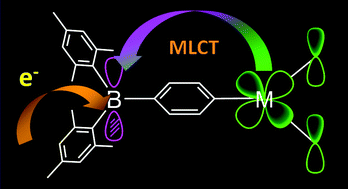














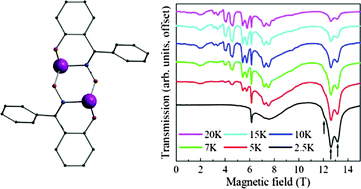 In this HOT Article, the serendipitous self-assembly of the complex [MnIII2ZnII2(Ph-sao)2(Ph-saoH)4(hmp)2], whose magnetic core consists solely of two symmetry equivalent Mn(III) ions linked by two symmetry equivalent –N–O– moieties, provided Brechin and co-workers with a relatively simple model complex with which to study the magneto-structural relationships in more complicated polynuclear oxime-bridged Mn(III) cluster compounds.
In this HOT Article, the serendipitous self-assembly of the complex [MnIII2ZnII2(Ph-sao)2(Ph-saoH)4(hmp)2], whose magnetic core consists solely of two symmetry equivalent Mn(III) ions linked by two symmetry equivalent –N–O– moieties, provided Brechin and co-workers with a relatively simple model complex with which to study the magneto-structural relationships in more complicated polynuclear oxime-bridged Mn(III) cluster compounds.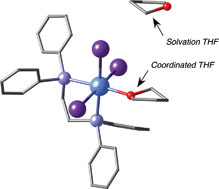 In this HOT article, Díaz-Torres and Alvarez have developed a scale which attempts to quantify the weakly coordinating character of a variety of solvents and anions towards a transition metal or a lanthanide. This was made possible by analyzing crystal structures for the presence of coordinated and uncoordinated groups (solvents or anions) in the presence of a transition metal or a lanthanide and extracting from this coordinating ability indices. These indices should prove very useful in providing general trends allowing comparison between different solvents or anions and should be very useful for the broad organometallic community.
In this HOT article, Díaz-Torres and Alvarez have developed a scale which attempts to quantify the weakly coordinating character of a variety of solvents and anions towards a transition metal or a lanthanide. This was made possible by analyzing crystal structures for the presence of coordinated and uncoordinated groups (solvents or anions) in the presence of a transition metal or a lanthanide and extracting from this coordinating ability indices. These indices should prove very useful in providing general trends allowing comparison between different solvents or anions and should be very useful for the broad organometallic community.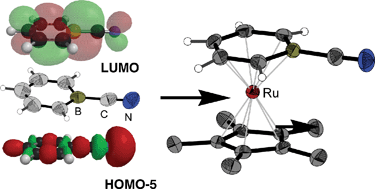 In this HOT article, Cade and Hill describe the synthesis of a salt of the 1-borabenzonitrile anion as its tetrabutylammonium salt and a preliminary exploration of its coordination chemistry in which it behaves as neither a conventional nitrile nor an isonitrile. The authors present computational, spectroscopic and crystallographic evidence for the heterocycle and a ruthenium complex containing the anion as an “arene” ligand.
In this HOT article, Cade and Hill describe the synthesis of a salt of the 1-borabenzonitrile anion as its tetrabutylammonium salt and a preliminary exploration of its coordination chemistry in which it behaves as neither a conventional nitrile nor an isonitrile. The authors present computational, spectroscopic and crystallographic evidence for the heterocycle and a ruthenium complex containing the anion as an “arene” ligand. A group of Spanish scientists have investigated the intramolecular [4C+3C] cycloaddition reaction of allenedienes in this Dalton Transactions Hot article.
A group of Spanish scientists have investigated the intramolecular [4C+3C] cycloaddition reaction of allenedienes in this Dalton Transactions Hot article.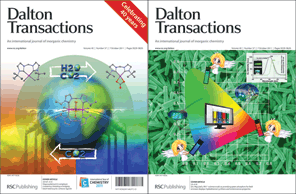 Check out the latest cover artwork for
Check out the latest cover artwork for